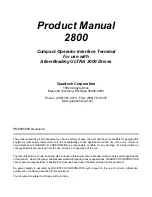
Fan Powered Variable Volume Terminal uniTs
13
priceindustries.com | FAn Powered VArIAbLe VoLume TermInAL unITs - manual
PNEUMATIC CALIBRATION PROCEDURES
CP101
General
1. Reconnect the thermostat tube to the controller if it has
been removed during the calibration procedure.
2. Disconnect the gauge and replace the caps on the tees.
3. Replace the protective cover.
CP101
1. Damper Action
i. Damper action is factory set. To reset action, loosen
damper selection switch screw and align desired
action with the damper position. Retighten screw.
ii. Actuator must be repositioned to provide appropriate
fail safe position.
2. Reset Start Point
i. Reset start point is factory calibrated to the specified
setting on the control assembly label.
ii. To field adjust, remove the gauge tap cap at “G” and
attach a 0 - 30 psi pressure gauge.
iii. Adjust the thermostat pressure at “T” port to the
desired start point value with a gradual switch
or pressure regulator. (Start point is lowest span
pressure).
iv. Adjust reset start knob until the gauge pressure
begins to increase slightly (greater than zero but less
than 0.3).
v. Replace gauge tap cap.
3. Reset Span
i. Reset span is factory calibrated to the specified
setting on the control assembly label.
ii. To field adjust, remove the gauge tap cap at “G” and
attach a 0 - 30 psi pressure gauge.
iii. Adjust the thermostat pressure at “T” port to above
15 psi.
iv. Adjust reset span knob until the gauge pressure is
equal to the desired reset span (total span pressure,
not end span pressure).
v. Replace gauge tap cap.
4. Air Volume Limits
i. Remove the caps from the tees in the HI (red) and LO
(green) tubes leading from the air flow sensor in the
assembly inlet. Connect a differential pressure gauge
to the tees. A gauge with a 0 to 1 inch w.g. scale is
recommended.
ii. Refer to the calibration curve for the size assembly
being serviced. From the curve read the differential
pressure across the sensor for the required air flow.
iii. Alternately, calculate the differential pressure from the
equations on
page 13
.
direct acting Cooling or reverse acting Heating
1. Adjust the minimum air flow limit first.
2. Set the thermostat signal to 0 psi or disconnect the
thermostat tube from the controller.
3. Adjust the “LO STAT” dial on the controller (center knob)
until the gauge reads the required differential pressure for
minimum air volume. Turn the dial slowly, allowing time for
the damper actuator to complete its travel in response to
the adjustments.
4. Adjust the maximum air flow limit, after verifying the
minimum air flow limit is set correctly.
5. Apply 15 psi minimum air pressure to the thermostat
connection at the controller.
6. Adjust the “HI STAT” dial on the controller (outer knob)
until the gauge reads the required differential pressure for
maximum air volume. Turn the dial slowly, allowing time for
the damper actuator to complete its travel in response to
the adjustments.
7. Cycle the thermostat several times. This can be quickly
accomplished by removing the cap from the gauge tap
(Port G) and varying the bleed rate with finger pressure.
Replace cap and check the air flow limits. If set points have
changed, repeat steps 1 to 7.










































